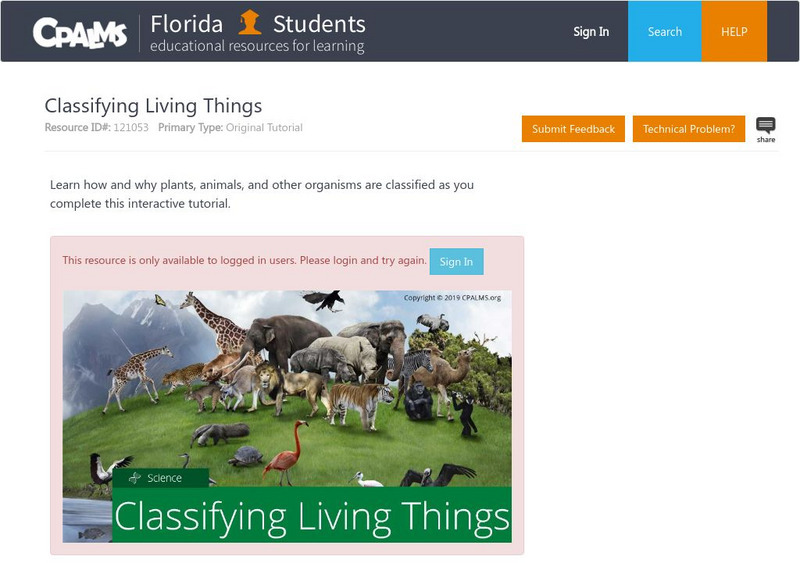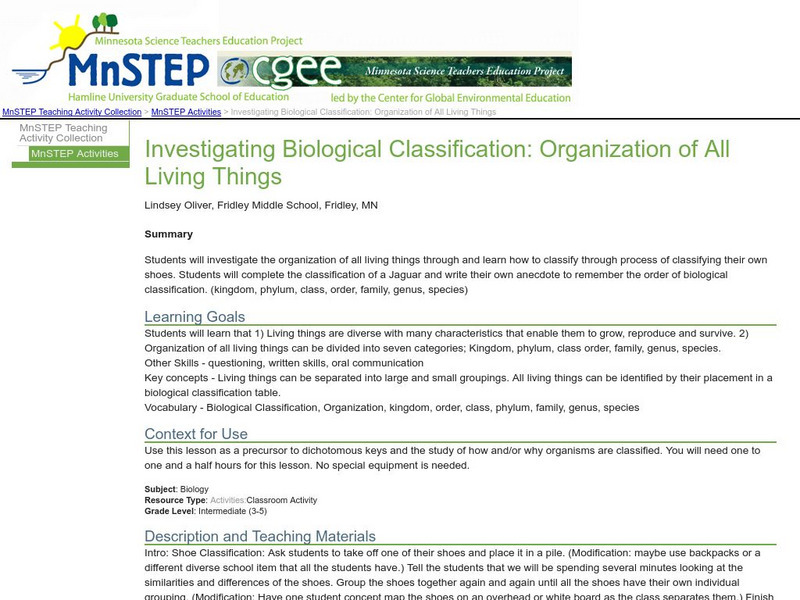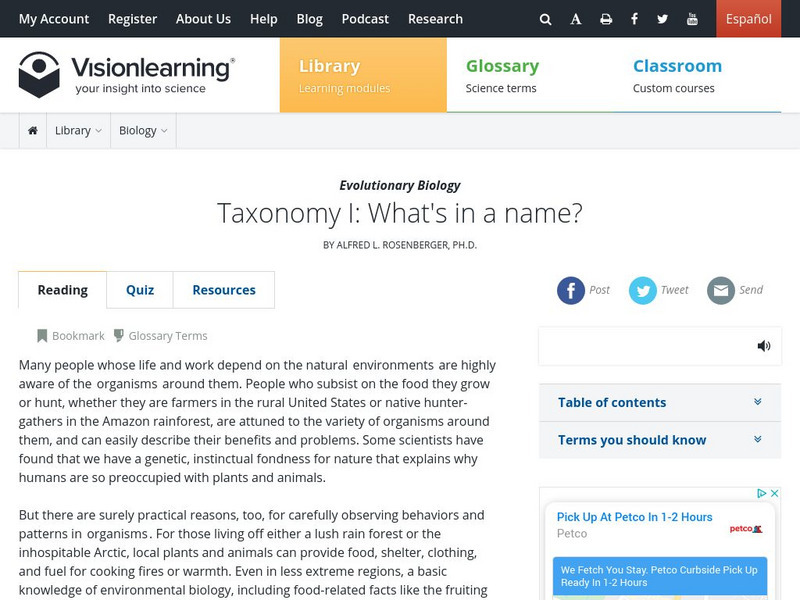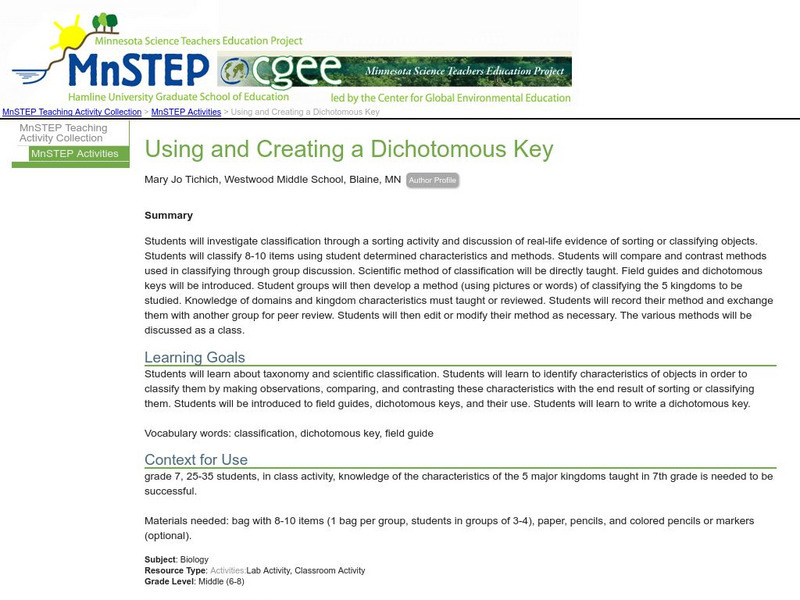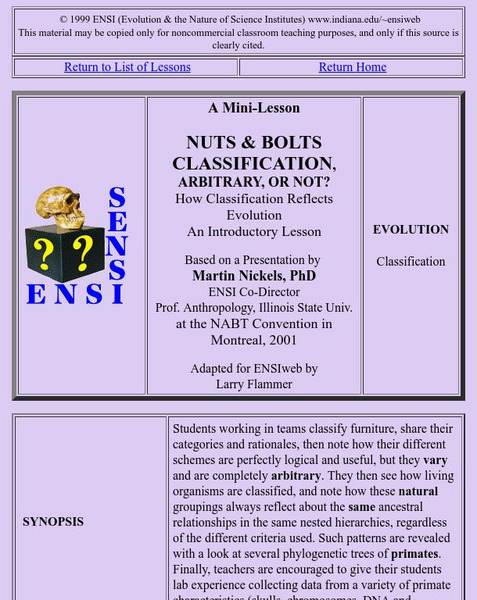CPALMS
Florida State University Cpalms: Florida Students: Classifying Living Things
Learn how all living things are classified.
CK-12 Foundation
Ck 12: Life Science: 11.9 Organization of Living Things
Learn the system that scientists use to classify living things.
Science Education Resource Center at Carleton College
Serc: Investigating Biological Classification: Organization of All Living Things
All living things can be identified by their placement in a biological classification table. Learners will investigate the organization of all living things and learn how to classify through the process of classifying their own shoes....
Mocomi & Anibrain Digital Technologies
Mocomi: Kingdom Classification of Living Organisms
Learn about who created the classification of living things, how they are classified, and the six different kingdoms.
Vision Learning
Visionlearning: Biology: Taxonomy I: What's in a Name
Instructional module focusing on biological classification. Discussion includes Carolus Linnaeus' taxonomic classification system for organizing and classifying living things. Site also includes an interactive practice quiz and links...
The Franklin Institute
The Franklin Institute: Living Things Families
What do centipedes and crabs have in common? What's so special about a backbone? Check this site out from The Franklin Institute if you are interested in biology and classification.
Center for Educational Technologies
Wheeling Jesuit University: How Are Things Divided Among Earth's Four Spheres?
See if you can classify various objects in the categories of land, water, air or living thing. This activity is interactive and you will receive a score for your performance.
Science Education Resource Center at Carleton College
Serc: Investigating Plant Life in Our Nature Center
In this Nature Center activity, students will apply knowledge from our classifying living things unit. They will compare what they already know about leaves to actual leaf samples. After collecting 5 leaves and keeping them in a journal,...
Alabama Learning Exchange
Alex: I Know What I Am, but What Are You?
During this instructional activity students will develop an understanding of how to classify living things and what creates the distinction among them. They will learn to classify living things by effects, environment, and activity.
City University of New York
Classification: Bringing Order Out of Chaos
A self-directed module on all aspects of biological classifications that covers the species problem, diversity and chaos, cladistics, putting things in groups, and so on.
Soft Schools
Soft Schools: Classification of Organisms Quiz
Take an interactive quiz over the classification of living things. After completing the quiz, check your score, and then revisit any incorrect question for further review.
E-learning for Kids
E Learning for Kids: Science: Caribbean Sea: Mexico: What Is Classifying?
Christina wants to classify all kinds of different things. Help her sort things into main groups.
Utah Education Network
Uen: Classify Yes, but Is It Alive?
Do you know the traits something that is alive? Test your knowledge of the traits of life by identifying objects as alive, not living, or once alive.
Alabama Learning Exchange
Alex: Taxonomy: The Importance of Classifying
This is a technology-based, hands-on Biology lesson used to introduce the topic of Taxonomy and the importance of classifying. Students will listen to a podcast about classifying every living thing on Earth. Students will then give some...
Science Education Resource Center at Carleton College
Serc: Investigating Insects in Nature
In this lab, students will collect insects while making close observations of living things. They will then classify insects into seven common groups based on characteristics discussed in the classroom.
Science Education Resource Center at Carleton College
Serc: Using and Creating a Dichotomous Key
Middle schoolers will investigate classification through a sorting activity and discus real-life evidence of classifying objects.
CPALMS
Florida State University Cpalms: Florida Students: Diagramming Diversity I
Identify how living organisms are classified according to their evolutionary history. Recognize how a hierarchical classification scheme can be used to classify living organisms based on physical characteristics.
ClassFlow
Class Flow: Living and Nonliving
[Free Registration/Login Required] Flipchart details characteristics of living and nonliving things, then asks students to classify. Activote questions are included.
Indiana University
Is Classification Arbitrary or Not?
Students transition from classifying furniture to an understanding of classification of living organisms in this thorough lesson plan site.
Soft Schools
Soft Schools: Classification Quiz
Take this interactive, multiple-choice quiz over classification of organisms, then review your score and any missed questions at the end.
Alabama Learning Exchange
Alex: Classification
This lesson will explain the reasons that society groups and classifies. The lesson has a hands-on component that helps students connect everyday grouping with the way that scientists group and classify all living organisms.
CPALMS
Florida State University Cpalms: Florida Students: Diagramming Diversity Ii
Expand understanding of classification with this tutorial designed to help you learn how living organisms are classified according to their evolutionary history.
Michigan Reach Out
Reach Out Michigan: Being Alive
This site provides a basic lesson plan that classifies objects as alive or not alive. Good for early elementary.
Other
Science4 Us: Animals
In online and offline activities, students broaden their understanding of animals by learning to identify and classify animals into six categories: mammals, birds, fish, amphibians, reptiles, and invertebrates.
